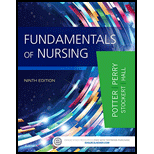
Concept explainers
To describe:
The below-mentioned case in terms of the ethical principles that it raises on referring the nursing code of ethics to compose your response.
Case summary:
A 17-year-old female patient with sickle cell disease was admitted for the treatment of sickle cell crisis. This sickle cell crisis could cause extreme pain due to the clumping of red blood cells which in turn impede the blood flow thereby causing extreme pain. The patient needs comfort management and aggressive fluids. The patient continues to report about the pain even though on receiving pain medications. She is apart from her friends and family members and she also complains about the surrounding environment including the treatment procedures. The shift report states that the patient is manipulative. The dose of pain medication is not increased on concerns about the risk of addiction.
Explanation of Solution
The basic principles of health care in nursing practices include beneficence, nonmaleficence, autonomy, fidelity and justice.
In terms of ethical principles, this case could be responded in terms of justice, beneficence, nonmaleficence, fidelity, and justice. All these ethical principles should be applied in treating this patient.
Justice: The patient should be ensured with the care for her condition.
Beneficence: It is the main fundamental principle in medicine and nursing practices. The term beneficence refers to taking positive and appropriate actions for the well-being of this patient.
Nonmaleficence: This term refers to the avoidance of harm or hurt. In this case, the patient is provided with comfort management and aggressive fluids in order to avoid the occurrence of stroke and also to avoid the pain.
Fidelity: This term implies the agreement of ensuring access the care in this patient even though her reports stating that she is manipulative.
The above-mentioned case is described in terms of ethical principles. This case is described in the principle of beneficence, justice, nonmaleficence, and fidelity.
Want to see more full solutions like this?
Chapter 22 Solutions
Fundamentals of Nursing, 9e
- explain an abdominal exam?arrow_forwardDiscuss β -Lactam antibiotics under the following subheadings Classifications of penicillins Classification of Cephalosporins General Mechanism of Actions Clinical Indications of penicillins and cephalosporins Adverse effects of β-lactamsarrow_forwarda. Define neoplasm b. Differentiate between benign and malignant tumours c. Describe the molecular basis of cancerarrow_forward
- differentiate the extra heart sounds S3,S4, murmurs and gallopsarrow_forward• Define shock and list types of shock • Discuss pathogenesis of septic shock. • Enumerate the stages of shock. • Define oedema and describe the pathophysiologic mechanisms of oedema with examples.arrow_forwardDiscuss Hypertension under the following headings: Definition Diagnosis Non-pharmacological intervention Drugs Classification Management of a Hypertensive emergencyarrow_forward
- Explain how the answer could be 2 or 1.8 WITHOUT changing the questionarrow_forwardoverview of the neurological system, cranial nerves and what part of the body it innervatesarrow_forwarddifferentiate structure and function of the peripheral vascular system. what are the normal and abnormal findings of the peripheral arterioles and peripheral venous systemarrow_forward
 Phlebotomy EssentialsNursingISBN:9781451194524Author:Ruth McCall, Cathee M. Tankersley MT(ASCP)Publisher:JONES+BARTLETT PUBLISHERS, INC.
Phlebotomy EssentialsNursingISBN:9781451194524Author:Ruth McCall, Cathee M. Tankersley MT(ASCP)Publisher:JONES+BARTLETT PUBLISHERS, INC. Gould's Pathophysiology for the Health Profession...NursingISBN:9780323414425Author:Robert J Hubert BSPublisher:Saunders
Gould's Pathophysiology for the Health Profession...NursingISBN:9780323414425Author:Robert J Hubert BSPublisher:Saunders Fundamentals Of NursingNursingISBN:9781496362179Author:Taylor, Carol (carol R.), LYNN, Pamela (pamela Barbara), Bartlett, Jennifer L.Publisher:Wolters Kluwer,
Fundamentals Of NursingNursingISBN:9781496362179Author:Taylor, Carol (carol R.), LYNN, Pamela (pamela Barbara), Bartlett, Jennifer L.Publisher:Wolters Kluwer, Fundamentals of Nursing, 9eNursingISBN:9780323327404Author:Patricia A. Potter RN MSN PhD FAAN, Anne Griffin Perry RN EdD FAAN, Patricia Stockert RN BSN MS PhD, Amy Hall RN BSN MS PhD CNEPublisher:Elsevier Science
Fundamentals of Nursing, 9eNursingISBN:9780323327404Author:Patricia A. Potter RN MSN PhD FAAN, Anne Griffin Perry RN EdD FAAN, Patricia Stockert RN BSN MS PhD, Amy Hall RN BSN MS PhD CNEPublisher:Elsevier Science Study Guide for Gould's Pathophysiology for the H...NursingISBN:9780323414142Author:Hubert BS, Robert J; VanMeter PhD, Karin C.Publisher:Saunders
Study Guide for Gould's Pathophysiology for the H...NursingISBN:9780323414142Author:Hubert BS, Robert J; VanMeter PhD, Karin C.Publisher:Saunders Issues and Ethics in the Helping Professions (Min...NursingISBN:9781337406291Author:Gerald Corey, Marianne Schneider Corey, Cindy CoreyPublisher:Cengage Learning
Issues and Ethics in the Helping Professions (Min...NursingISBN:9781337406291Author:Gerald Corey, Marianne Schneider Corey, Cindy CoreyPublisher:Cengage Learning





